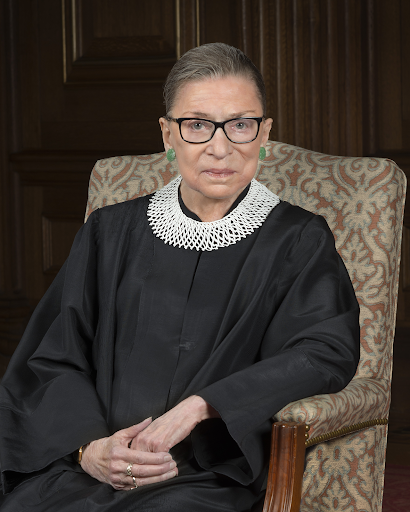RBG’S LEGACY

Photograph by The Supreme Court
Ruth Bader Ginsburg, known affectionately by her fans as “The Notorious RBG,” passed away on Friday, September 18.
Like many things this year, the passing of Justice Ruth Bader Ginsburg immediately became politically polarized. On one side, Republicans began scrambling to find a replacement for Ginsburg’s seat on the Supreme Court. On the other side, Democrats rebutted by calling out Republicans for contradicting their 2016 stance against filling Supreme Court Justice seats during election years.
What became lost among the partisanship was the legacy of Ruth Bader Ginsburg. Justice Ginsburg was undoubtedly a leading figure in the feminist movement, as litigator and law professor to judge and pop culture icon. Her impact has expanded not only the rights of women but the rights of all people.
Beginning with her work as a lawyer in the 1970s, Ginsburg fought to take down gender discriminatory laws, arguing for a new interpretation of the Constitution. In cases such as Reed v. Reed in 1971, Ginsburg argued against a law that violated the Equal Protection Clause of the 14th Amendment “on the basis of sex.” The law, in which fathers were preferred over mothers to administer a child’s estate in Idaho, was struck down by the Supreme Court “as arbitrary and not based on legitimate objectives” (Ms. Magazine). It was an unprecedented event.
Ginsburg went on to further strengthen this precedent as founder of the ACLU’s Women’s Rights Project, which “has been the principal group responsible for systematic legal reform through the courts in the areas of women’s equality and economic rights” (The ACLU).
Ginsburg served as a D.C. Circuit Judge for 13 years before ascending to the Supreme Court in 1993, becoming the nation’s second female Supreme Court Justice. On the bench, Ginsburg fought for equality in education, disability rights, and environmental policy in addition to gender equality. In authoring decisions and in dissent, Ginsburg has treated the Constitution as our society— both evolving.
In 2015, The New York Times published a conversation between Ginsburg and one of her contemporaries in the fight for gender equality, the American journalist Gloria Steinem.

Recollecting obstacles overcome and struggles faced, the two pondered their life’s work and the work still to do. During the early years of second-wave feminism, Ginsburg recalled what “disturbed me [Ginsburg] was when people would say: “What are those women doing?” She added, “they’re just riding the coattails of the civil rights movement.” However, Ginsburg and Steinem knew that there would be no feminist movement without the Black women who help pioneer it. “They are profoundly connected,” said Steinem.
In the country’s current political climate with two distinct sides, what Ginsburg and Steinem saw then is still relevant now. “What we want in the future will only happen if we do it every day,” said Steinem. “So, kindness matters enormously. And empathy. Finding some point of connection.”
There is no arguing that Ginsburg’s legacy is expansive. However, feminists across the country are still disheartened by the news of Ginsburg’s passing for fear of her progress being lost. But Steinem has hope for the fourth wave feminist movement, just as she and Ruth Bader Ginsburg had for the second wave.

Giulianna Bruce is a senior at MCDS and she’s so excited to be this year's Editor-in-Chief of The Spartacus! Giulianna joined three years ago with the...












Ariana Clarke • Oct 12, 2020 at 12:28 am
Rest in peace to the Notorious RBG. She was a legend and a hero. She made the United States a better place for women. Thank you for writing this this story on her life to remember her and how much she has done for women’s rights.
Abigail Kiralihn Cherenfant • Sep 28, 2020 at 8:58 pm
Rest in power, RBG